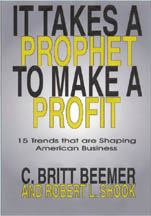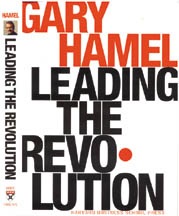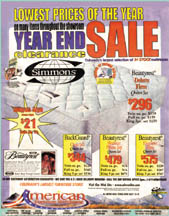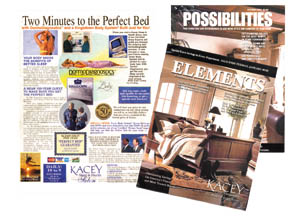Trends that will shape your business this next year.

It Takes More Than A Prophet To Make A Profit: C. Britt Beemer’s new book has important information in it, but the future is not something that just happens. Read Beemer’s book, then roll up your sleeves and strive to create the future you want for your company.
How are you going to attract customers to your store in the coming months? The stock market has been a cause for concern and energy costs are hurting, especially in the blue collar sectors. Should you wait the tough times out? The great furniture merchants around the country are pulling in their belts and observing economic indicators with caution. They are doing something else as well. They are sharpening their tools and checking for leaks, waste and junk. They are inspiring their troops with an upbeat, confident attitude. In addition, they are moving to increase market share.
For those of you who would like to know what the future may hold, C. Britt Beemer recently published a book titled: It Takes a Prophet to Make a Profit.
Beemer is most adept when gathering data, and his book has many excellent ideas. Beemer’s book presents some ideas about what might happen. Another good resource is the new book Leading The Revolution by Gary Hamel that provides ways to "seize" the future. From Hamel’s perspective, the goal is not to figure out what might happen, but rather to imagine what you can actually make happen. This is the concept of Visionary Management.
With this caveat in mind, let’s examine what Beemer has to say. Of the fifteen trends Beemer offers in his book, eleven seem to offer direction for furniture retailers:
1. Americans have less leisure time.
2. Community involvement enhances a company’s reputation.
3. There is a growing obsession with the internet.
4. American companies cannot expect employee loyalty - they must earn it.
5. Customers are reluctant to pay full retail price.
6. Dual income families are becoming single-income families.
7. Frequent buyer programs have come to govern consumer-spending habits.
8. Today’s consumers want brand-name products.
9. Gaming casinos and lotteries have joined America’s mainstream. 10. People today complain of feeling invisible.
11. Today’s marketing efforts are not keeping pace with changing customer demands.
 |
Gary Hamel Says: “Companies Fail To Create The Future...
not because they fail to predict the future, but because they fail to imagine it.”
Seeing things from a different perspective than Beemer, Hamel says that a fresh way of looking at things is often more valuable than sheer brainpower.His book is about making the future happen, not predicting it. |
Americans Have Less Leisure Time So Make Your Ads More Productive
Less leisure time means less time for family vacations, to exercise, to participate in sports, read, or watch television… and less time to shop! Americans are overworked. (Beemer says a typical 2-career couple worked 247 more hours in 1999 than in 1989).
They can’t get everything done, feel used up at the end of the day, have stress-caused health problems, and over 1/3 strongly favor looking for another job. All the new gadgets and technologies have just made things worse. One source of serious stress is sleep deprivation.
The following ideas can help you to save your customers time (trend #1), and cause you to do more business in tough times.
Improve Your Mattress Advertising.
Use information about sleep to create mattress ads that really work. These ads should feature health benefits and photos of active people showing the ultimate result of better sleep. The big mistake most retailers make is that their ads sell better sleep for every dealer in the city. Likewise, their Beautyrest ads look like national ads and sell Beautyrest for everyone, not just for the advertiser. If a competitor can run your headline, it is the wrong headline. For example, never say "Beautyrest Sleep Sale" without quickly adding: "We guarantee you the perfect Beautyrest for your body" and show your "sleep-on-it" guarantee.
 |
Same Old Same Old Is Not Working
In tough times more is required to inspire reluctant consumers. Many stores advertise a typical list of "free" value-added items that many consumers consider table stakes.
Other stores advertise brands, but could do much more to distinguish their own store’s strengths. Also, This ad advertises an each piece price, sold only in sets. Reminds one of the old joke about the optometrist. When asked the price of a pair of glasses, he says: "$45," then if the customer doesn't flinch, he adds, "Per Lens." Compare these ads with the ads on page 90. |
Use Print Advertising Dollars More Effectively.
Beemer says people today look at more ads and shop fewer stores. In 1980 they looked at 2.3 ads and visited 2.8 stores. Today they look at 4.3 ads and visit 1.5 stores. Today’s consumer saves time by:
•Doing less comparative shopping.
•Shopping only stores that carry what they want and have it in stock.
•Buying more brand name products.
Here is an opportunity to use print most effectively. Once consumers decide it’s time to make a high ticket furniture purchase that may have been delayed for years, they begin to look at print ads. They don’t just sit in front of the TV and hope to see a commercial on mattresses or a bedroom.
In addition to looking at more ads, they shop in fewer stores. It is, therefore, critical that the ad copy be highly effective. Just imagine if you could buy ad space for half or one-third the amount it costs your competition. You can! Effective print out-pulls weak ads by several times. Add an element here, another there, to increase response by a fraction of a percentage point or so. This response adds up. I can make a living increasing the effectiveness of ad copy because even old-hands at checking ads forget dozens of "small" things that add up to greater effectiveness (See Who Writes Your Ad Copy? 10/98 & 12/98 FURNITURE WORLD posted to furninfo.com in the Marketing Management Index.) Merchants need to take the time to include all the points that make ads work. All the factors of who-what-when-where-how-and-why must be answered. Don’t pass over this too quickly.
For example, consider the "who" factor. Repeatedly, furniture stores fail to mention how long they have been in business. If your store has been around for fifty years, then tell your customers this fact in print, on TV and on the floor. This is especially important when times are tough. The newcomer furniture store that is giving you fits just loves the fact that you fail to mention your factors like stability, safety and experience. A line such as: "Forty-seven years of serving the Mobile Area", means something. Maybe picking up or losing a new customer or two per ad. Don’t give away your unique factors, broadcast them.
 |
Kacey Fine Furniture has captured much of the high end market in Denver by loading their ads with benefits and unique factors. Sam Fishbein, CEO, creates print that tells customers why they should buy their furniture and mattresses from only Kacey. The color magazine-type inserts on the right have effective copy throughout. Leslie Fishbein, President, and the talent for their TV commercials, uses the elegant interiors of Kacey's showrooms in her spots. She tells the Kacey story with a backdrop that no competitor can duplicate. |
Inspire Staff to Avoid Careless Mistakes.
Consumers are not forgiving. They expect you to "get it right the first time" and deliver what you advertise.
Motivate Staff to Treat Customers Like Gold.
The amount of close contact customers have with an employee strongly influences their buying decision and your average sale.
Advertise Services That Customers Believe They Can’t Get Elsewhere.
Strive to make sure that every ad sells only for your store. This may sound obvious, but look carefully at some of the mattress ads and the Natuzzi coop ads. You can put any dealers sig on them and no one will know the difference. That’s why guarantees, years in business, selection and unique services must make every ad you run, yours alone.
The Right Brand Names at the Right Prices.
Consumers know only a handful of furniture brands. In spite of this limitation, your ads should name brands all the time, even when they are not well known. This adds to the credibility of your selling proposition, especially when the less or unknown brands are mentioned in close association with known brand names. This is true of ads as well as sales talks.
Be Properly Staffed.
People walk away very quickly these days if they are not quickly acknowledged. Try positioning a "greeter" at the door during peak sales periods. It takes the sting out of waiting if a smiling face says "Hi folks!" and can direct them to a part of the store where they can momentarily browse. This "greeter" can even be a bright young teenager, hired at low cost. Time saver must include: great sales consultants, good signage to direct customers and good phone skills with real real people answering the phone.
Convenience and No-Hassle Service.
When planning your media, remember that customers used to drive ten miles to make a major purchase. Today the maximum is seven on the average.
Be sure your guarantee is simple and reassuring. Don’t let the lowest common denominator of customer determine your personnels’ attitude toward all your good customers.
Vision & Presence.
A great line from page 57 of Beemer’s book: “Henry Ford said: “Poverty is not a man without a dime, it is a man without a dream”; As Americans, we must make sure America’s dream is attainable for everyone.”
Indeed, this dream or vision is more important than ever in difficult business periods. We are the creators of our futures. The boss must have a vision, and must exude confidence and caring at all times. Your associates watch you closely, and your attitude will be reflected in their own.
The greatest insights have often emerged from the chaos of difficult problems. Brilliant ideas burst forth from chance conversations, unusual experiences and fresh information. Indeed, the great furniture men and women are those who continually confront their associates with challenges, who upset the daily routines with the unexpected. They do this not to be annoying, but rather to stimulate flashes of creative insight. This should be your organizational imperative for whatever the future may hold: "to strive, to seek, to find, and not to yield."
NEXT ISSUE: In the next issue we will examine more of the things you can begin doing that will help you do more business in tough times and also address the trends of the future. You can use these times to get ahead of the curve and be ready for the boom times that will surely come.
Larry Mullins, President of UltraSales, Inc., has 30+ years experience in the front lines of retail furniture marketing. Larry's mainstream executive experience, his creative work for "promoter-specialists," and study of advertising principles has enabled him to continually develop new High-Impact strategies for independent furniture retailers that are sound, complete, and innovative. Inquiries can be sent to Larry care of FURNITURE WORLD at editor@furninfo.com.